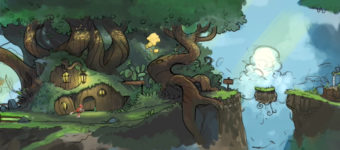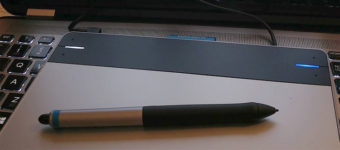Best Watercolor Painting Books For Beginners & Professional Artists
Watercolors are a terrific medium for expressing creativity. They let you express ideas looser than digital painting or using dry mediums like charcoal.
Not every concept artist or animator will bother to learn watercolor. It does take some dedication and a focus on more traditional techniques.
But if you’ve ever wanted to do some watercolor stuff for fun or for work, these books are sure to help.
In this list you’ll find tons of guides for complete beginners and some for more experienced painters. With practice you can start painting your own backgrounds or even creating fun watercolor projects to hang on your walls at home.
Everyday Watercolor: Learn to Paint Watercolor in 30 Days


Everyday Watercolor by Jenna Rainey is one of the newest books in this list. It was first published in late 2017 totaling just over 220 pages of instructions and guidance on watercolor painting.
This is truly a beginners manual to the entire painting process. It covers the medium, techniques, and even some of the fundamentals you should apply to your watercolor work.
The book splits into 5 sections with each part covering a different area. You’ll learn about painting forms, lighting, and complex shapes including human gestures.
Towards the end you’ll find a bunch of exercises for painting landscapes and one final project: painting a watercolor jungle scene.
From start to finish you’ll pick up a lot of practical techniques you can apply to any type of watercoloring you do. Not to mention this is great for beginners with little-to-no prior experience since it holds your hand along the way.
Modern Watercolor


Another newer book is Modern Watercolor by by Kristin Van Leuven.
I would consider this an even easier introduction to the medium for beginners. However I don’t think it goes as deep as Rainey’s book, so it may work better for complete novices who feel intimidated just picking up a brush.
Early chapters teach you how to start with watercolors. Simple things like how to hold the brush, how to apply paint to the canvas, and how to think about your brush strokes.
Later chapters teach you how to practice on certain subjects like plants, flowers, animals, and environments.
Some of these later lessons can be complex but they’ll teach you a lot in the process.
And really, once you understand how to lay down brush strokes with purpose you’ll be well on your way to crafting beautiful watercolors.
The Watercolor Course You’ve Always Wanted


In the learning process you’ll always stumble into complex theory and general “ideas” to apply into your work. But it’s practice that really makes the difference in your skill.
The Watercolor Course You’ve Always Wanted understands this gap and tries to bridge theory & practice together into one manual.
Author & artist Leslie Frontz has over four decades of experience working as an artist. She guides you through a series of exercises with a focus on the most crucial semi-universal concepts in watercolor painting.
Over 190 pages you’ll learn how to interpret shapes, lines, and values from life or from photographs.
This works a little differently when you’re working in watercolor and it can be tough moving from pencil to painting.
But this is one of the strongest resources you can get with a clear goal of teaching you how to paint anything in watercolor.
Naturally you won’t figure it out right away. But if you stick with it you’ll see radical improvements over time.
Watercolor School


Artist Hazel Harrison wrote Watercolor School back in 1993 published by Reader’s Digest.
It’s still one of the strongest guides to watercoloring with a very clear process. You learn how to plan your concepts and how to approach your subject before ever laying a mark.
This is crucial if you want your final piece to come out in a specific style, or to take up a specific portion of the composition.
Pre-planning is huge in this book. Same goes for technique and getting the right supplies beforehand.
But this is also a practical guide so you’ll be working through real exercises that force you to apply watercolors into your workflow.
Harrison talks about different brush techniques from splattering to sponge painting and some others you might try.
This doesn’t feel as linear compared to the other books mentioned above. Yet it’s still a gem with plenty of professional advice for artists just diving into watercolor painting.
10-Minute Watercolours


For a quick read with some pithy words of encouragement check out 10-Minute Watercolours.
This is not a complete guide to the medium and it’s certainly not a children’s book either. It rests somewhere in the middle where it assumes the reader has a little knowledge of art, but perhaps not so much experience in painting.
The writing style is super inspiring so it’ll encourage you to pick up a brush right away.
But it’s also a book with practical tips on brush strokes, handling your brush, and how to mix colors properly.
It may not be worthwhile for everyone considering the small size but it does make a nice quick read.
Watercolor 365: Daily Tips, Tricks and Techniques


On the flip side here’s a much larger book with a focus on bite-sized education.
Leslie Redhead created Watercolor 365 as a daily calendar-of-sorts. It’s meant to teach watercolors on a weekly basis with each chapter breaking down subjects into weeks.
In the beginning you’ll start with a lengthy introduction that talks about the basics of watercolor painting. This is fantastic for complete beginners who barely know how to hold a brush.
The intro runs for about 90 pages which covers basically everything you’d need to know. Then from there you’ll dive into exercises, lessons, and quick tips over a series of 30 weeks.
There’s plenty of troubleshooting tips and tidbits of advice both from Redhead and other watercolor artists.
I absolutely recommend this book for artists both starting watercolors, and artists with some experience who want to up their game.
The Tao of Watercolor


The Tao of Watercolor was first released in 1998 and it’s left quite an impression on the art world.
Artist and author Jeanne Carbonetti combines ideas from eastern philosophy and western painting techniques into this guide aimed at calming your soul through watercolors.
It’s full of watercolor paintings and plenty of ideas about painting that borrow from eastern belief systems.
Note this is not a direct step-by-step guide to watercoloring. In fact, it’ll probably be tough to follow as a complete beginner.
However it will help you think about art differently and force you to approach each piece from a different perspective.
That’s the biggest reason I still recommend this to all traditional painters. These pages have so much to offer in the way of balance, composition, and playfulness in your work.
Jean Haines’ World of Watercolour


The renowned watercolor artist Jean Haines paints in a truly unique yet powerful style that really grabs the eye.
Her book Jean Haines’ World of Watercolour offers a peek into her workflow with advice on tools, paints, techniques, and her general workflow.
Plus you get to learn a lot about Haines’ lifestyle from her early influences to what helped her develop the unique style she uses today.
The color theory section is incredibly useful from pages 48-86. These cover warm-up exercises and techniques you can use when mixing to make sure you’re getting the right colors for every piece.
Ultimately this book offers a beautiful peek into the mind of a very talented watercolor artist.
Haines does have another book called Paint Yourself Calm which makes an excellent follow-up read after this one.
Both are phenomenal but if you’re only looking to gab one then my vote goes to World of Watercolour.
Watercolor Painting: A Comprehensive Approach to Mastering the Medium


Here’s a much more advanced guide by artist Tom Hoffmann who delves into the real technicalities of watercolors.
His book Watercolor Painting: A Comprehensive Approach to Mastering the Medium aims to teach you the medium rather than the specific techniques for certain subjects.
Hoffmann writes about picking the subjects of your paintings carefully and observing a lot. He shares his advice on understanding what to paint(and what not to paint) to capture the essence of your subject.
Later chapters get into more practical tips for finding values, mixing colors, and handling hard/soft edges in your work. This can be tricky with a wet medium but Hoffmann has the experience to guide you through it.
In the very last chapter you’ll learn how to ultimately become your own teacher.
And this is crucial in every form of art, digital or traditional.
We did a recent interview with Kala from Hi-Rez Studios and she explained how she considers herself an “artist-taught artist”.
This is mostly accurate since everyone learns from someone, usually multiple people.
But as you improve it’s crucial to learn how to teach yourself so you can improve even faster. And that’s exactly what Hoffmann leaves you with in this book.
Mastering Watercolors: A Practical Guide


It’s pretty easy to find beginner’s materials for watercolor painting. But it’s tougher to find pro-level materials since few artists know how to teach “higher level” concepts with clarity.
But if there’s one book I recommend for intermediate-to-advanced painters it’s Mastering Watercolors: A Practical Guide by Joe Cartwright.
Joe has over twenty years of experience working in watercolors so it’s safe to trust his judgement.
And while this book is fairly small(about 110 pages) you’ll still find some incredibly poignant tidbits on brushwork, handling edges, and finding just the right tones for your paintings.
Later chapters teach you how to fix watercolor paintings and rework them without damaging what you already have on the canvas. He also shares experience with plein air painting and techniques for specific subjects like cities, landscapes, or challenging perspectives.
A must-read for anyone looking to improve their watercolor paintings. Even if you get just one nugget out of this book it’ll be something you’ll keep for life.
Painting in Watercolor: The Indispensable Guide


If I could share two things I love about this book it’s the layout and writing style.
Painting in Watercolor: The Indispensable Guide is just so darn easy to read.
Many chapters include step-by-step photos where you can see exactly what to do and what the author David Webb is going for.
Webb explains all the fundamentals of watercolor painting, but he covers a lot on techniques like lift-out and brush handling for smaller areas on the canvas.
Even if you consider yourself an expert in watercolors this book should have something to offer.
Plus with so many pictures it’s super easy to follow along. The book totals about 256 pages so it should keep you busy reading and painting for a while.
The Watercolor Artist’s Bible


I feel bad leaving this book ‘til last but I hope it still grabs your attention.
The Watercolor Artist’s Bible by Marylin Scott really lives up to its name.
This book has diagrams, sample paintings, photos, and plenty of advice on everything from your watercolor tools to your techniques in the medium.
You’ll also find some really cool demonstrations on how to paint waterscapes, buildings, fruit, flowers, people, you name it.
Over a total of 200 pages you’ll learn a ton of unique watercolor ideas that you can apply directly to your practice. This includes more advanced techniques like dry brushing and glazing.
If you’re just starting out this book may feel overwhelming, especially mid-way through. It starts off pretty simple but can get complex fast.
I still recommend it for anyone willing to dive into watercolors and put in some serious hours mastering the medium. It’s a book you’ll reference many times over in your practice sessions.













